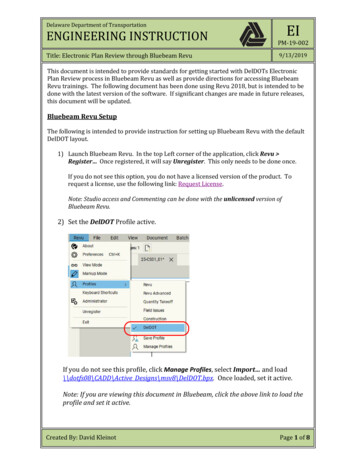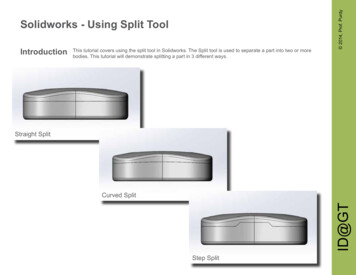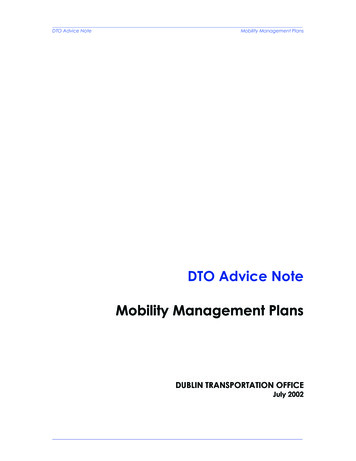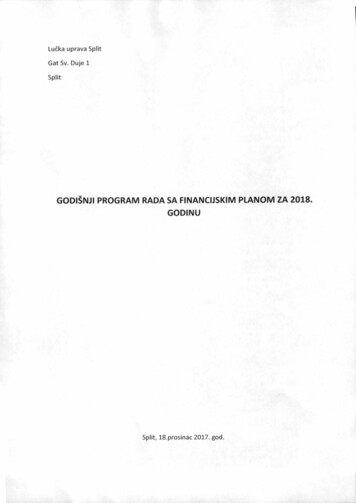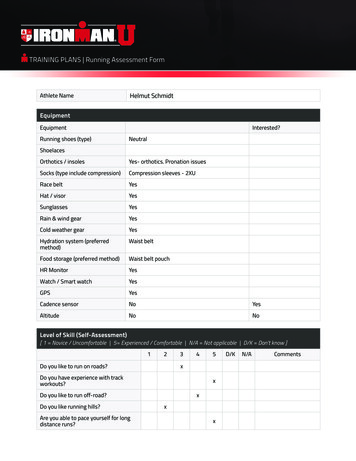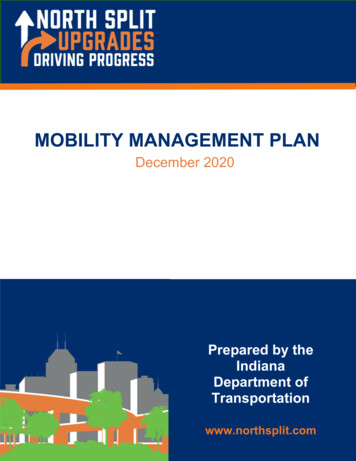
Transcription
MOBILITY MANAGEMENT PLANDecember 2020Prepared by theIndianaDepartment ofTransportationwww.northsplit.com
CONTENTS1INTRODUCTION. 1-11.1 Purpose of the Mobility Management Plan .1-11.2 Project Overview .1-11.3 Federal Environmental Review Process .1-41.4 Existing Roadway Network .1-41.4.1 Downtown Interstate System . 1-41.4.2 Downtown Arterial System. 1-51.5 Planned Road Closures and Restrictions .1-51.6 Mobility Management Plan Objectives .1-81.7 Report Organization .1-82SYSTEM TRAFFIC OPERATIONS DURING CONSTRUCTION . 2-12.1 Diversion of Through Trips to I-465.2-22.2 Downtown Traffic Operations .2-62.3 Anticipated Level of Disruption to Traffic Operations .2-83TRAFFIC OPERATIONS MANAGEMENT . 3-13.1 Contractor’s Traffic Management Plan (TMP) .3-13.2 Traffic Network Changes.3-13.2.1 Interstates and Interchanges . 3-13.2.2 Local Street Network Improvements . 3-33.3 Traffic Management and Intelligent Transportation Systems (ITS) .3-53.4 Incident Management and Response .3-64TRAVEL DEMAND MANAGEMENT . 4-14.1 Mode Shift and Ridesharing .4-14.1.1 Transit . 4-14.1.2 Carpools/Vanpools . 4-44.1.3 Non-Motorized Travel . 4-54.2 Work Rescheduling and Work Trip Reduction .4-74.2.1 Work Rescheduling. 4-74.2.2 Work from Home Programs . 4-84.3 Special Event Planning .4-9Mobility Management Plani11/20/2020
5COMMUNICATIONS AND PUBLIC OUTREACH . 5-15.1 North Split Public Involvement Plan .5-15.2 Communication Tools .5-15.2.1 Project Website . 5-25.2.2 Virtual Project Office . 5-25.2.3 Social Media . 5-35.2.4 E-Newsletters and SMS Text Messaging . 5-35.2.5 Paid Media Communications . 5-35.3 Advance Closure Notifications .5-45.4 Real-Time Traveler Information .5-55.5 Mobility Management Education Program .5-75.5.1 Transit and TDM Promotion. 5-75.5.2 Communication Tools . 5-76MOBILITY MANAGEMENT PLAN IMPLEMENTATION . 6-16.1 Summary of Mobility Management Plan Components .6-16.2 Mobility Management Plan Toolbox .6-1Mobility Management Planii11/20/2020
FIGURESFigure 1-1: Indianapolis Downtown Interstate System.1-3Figure 1-2: Interstate Access during Construction .1-6Figure 2-1: Estimated I-465 Traffic Changes during Construction .2-3Figure 2-2: Official North Split Detour Routes.2-5Figure 2-3: Estimated Downtown Traffic Changes during Construction .2-7Figure 2-4: Detour Signs for I-65 Approaching from the North .2-8Figure 3-1: Washington Street Interchange Adjustments .3-2Figure 3-2: Widened West Street Ramps .3-2Figure 4-1: Dedicated BRT Lane .4-2Figure 4-2: Commuter Connect Van .4-4Figure 4-3: Emergency Ride Home Brochure .4-5Figure 4-4: Monon Trail Construction Detour.4-6Figure 5-1: Virtual Project Office .5-2Figure 5-2. INDOT Mobile Smartphone App .5-6TABLESTable 1-1: Maximum Closure Durations .1-7Table 4-1: IndyGo Routes that will be Impacted by Bridge Construction.4-3Table 4-2: Improved Bicycle/Pedestrian Widths at Bridges .4-7Table 4-3: Major Local Event Days .4-9Table 5-1: Movement Closure Notification Periods.5-5Table 6-1: North Split MMP Component Matrix .6-2Mobility Management Planiii11/20/2020
1INTRODUCTION1.1Purpose of the Mobility Management PlanAs described in Chapter 503 “Maintenance of Traffic” of the Indiana Department of Transportation(INDOT) Indiana Design Manual (IDM), all INDOT projects require a Transportation Management Plan(TMP) and a Temporary Traffic Control Plan (TTCP). For projects that have significant impacts to thepublic, such as the North Split Interchange Rehabilitation Project (“North Split Project”), the TMPincludes a Transportation Operations Plan (TOP) and a Public Information Plan (PIP).INDOT is using a Design-Build Best-Value procurement to deliver the North Split Project. The DesignBuild Contractor has primary responsibility for development of the TMP and TTCP, with INDOT’soversight and approval. The Design-Build Contractor will develop and manage all construction phasing,traffic operations planning, and incident management activities within the work zone, and willincorporate other related components into the TMP.As described in IDM Section 503-4.0, the TOP is to include “strategies for the operations andmanagement of the work zone and all facilities affected by the work zone for projects determined tohave significant work zone impacts.” The Mobility Management Plan (MMP) is that part of the TOPfocusing on strategies for mitigating traffic congestion in the network outside the work zone.IDM Section 503-4.0 notes the strategies can serve transit, rail, air, and pedestrians in addition toroadway users. The MMP includes these strategies as well as actions to reduce the number of tripsutilizing the transportation network and shift the timing of these trips to periods when the system is lesscongested.This document presents the background and baseline strategies of the North Split MMP. The strategiesare expected to evolve as the project is implemented in order to meet changing needs, conditions, andopportunities. INDOT will prepare and execute the MMP, as well as the PIP, with support of the NorthSplit Project Team throughout the life of the project.One important source of changing conditions that will require monitoring and adjustment of the MMP isthe uncertain impact of the ongoing COVID-19 pandemic on long term travel demand and trafficcongestion. Congestion mitigation needs and strategies discussed in this plan are based on historic“typical” traffic patterns observed before the COVID-19 outbreak began. In March 2020, there was asudden and significant reduction in work commuting and corresponding increase in employees workingfrom home. While traffic volumes are now trending upward again, it is unknown when volumes ondowntown freeways might approach typical historic levels.1.2Project OverviewINDOT is developing a project involving the I-65/I-70 North Junction interchange (North Split) inIndianapolis, Indiana, in partnership with the Federal Highway Administration (FHWA). I-65 and I-70 arenationally significant corridors serving the Midwest and United States in four directions. The objective ofthis project is to meet the transportation needs at the North Split with a safe, well-functioning facility.The North Split interchange is the most-heavily traveled interchange in Central Indiana, accommodatingmore than 214,000 vehicles per day. Studies have shown that most traffic on downtown Indianapolisinterstates is local. They also have shown I-70 from the east (between I-65 and I-465) has the highestMobility Management Plan1-111/20/2020
peak-hour volumes in the state. On both I-65 and I-70, twice as much traffic is headed towarddowntown as away from downtown in the mornings, indicating a heavy commuter pattern.I-65 and I-70 are unofficially known as the “inner loop” where they pass through downtown Indianapolis(see Figure 1-1). The inner loop is approximately 4-1/2 miles long and provides 25 entrance and exitramps serving all sections of downtown. The downtown interstates were constructed in the late 1960sand early 1970s, with the last section opening to traffic in October 1976.Based on the condition of existing infrastructure, INDOT determined the North Split requires repair, andthe construction effort needed for this repair creates an opportunity to improve the safety andoperations of the interchange. The need for repairs in and near the North Split interchange is based onthe deteriorated condition of bridges and pavement. Bridges located in or near the interchange requirerehabilitation or replacement due to their structural condition. The pavement also requires rehabilitationor replacement.In addition to its poor physical condition, the interchange configuration is inefficient and poorly suited forthe volumes of traffic it is serving. Reconstructing the infrastructure to correct physical deficienciesprovides an opportunity to improve safety and reduce congestion by realigning ramps and merges inthe interchange area and correcting and eliminating existing weaving problems.Mobility Management Plan1-211/20/2020
Figure 1-1: Indianapolis Downtown Interstate SystemMobility Management Plan1-311/20/2020
1.3Federal Environmental Review ProcessThe National Environmental Policy Act of 1969 (NEPA) requires Federal agencies to prepare anenvironmental analysis for projects that may significantly affect the environment. The North Split Projectstudy area boundary identified in the NEPA documentation extends south along I-65/I-70 to theWashington Street interchange, east along I-70 to the bridge over Valley Avenue, and west along I-65to the bridge over Alabama Street. The study area extends further west along 11th and 12th Streets toIllinois Street.FHWA determined an Environmental Assessment (EA) to be the appropriate level of analysis for thisproject. The purpose of an EA is to determine if a project will have significant impacts on theenvironment. If not, a Finding of No Significant Impact (FONSI) is issued by FHWA, which marks theend of the NEPA process and documents the decision. If significant impacts are identified during theEA process, additional studies or an Environmental Impact Statement (EIS) may be required.An EA describes why the transportation project is needed, the alternatives that were studied, and theirpotential impacts. It also provides opportunities for public and agency comments. Environmentalimpacts play an important role – alongside other considerations such as performance and cost – indecisions made about a project. The EA for the North Split Project was made available for the public toreview and a public hearing was held on August 3, 2020. The project sponsor (INDOT) is required toconsider all the comments received during this process before making final decisions about the project.The EA was approved in July 2020, and FHWA then issued a FONSI for the North Split Project inSeptember 2020.1.4Existing Roadway NetworkAccess to and through downtown Indianapolis is provided by a system of interstate highways andarterial streets. These major roadways link with collector and local streets to provide access toindividual properties. From a system perspective, the operations of interstates and arterials are tiedtogether. The characteristics of both components of the existing roadway network are described below.1.4.1Downtown Interstate SystemAlthough the interstate system in downtown Indianapolis is often referred to as the “inner loop,” it isactually in the shape of a backward C, as shown in Figure 1-1. I-65 forms the north leg, I-70 forms thesouth leg, and I-65 and I-70 share the east leg on a common alignment. Connections between I-65 andI-70 are provided at the “corners” of the inner loop via “system interchanges,” and access to thedowntown street system is provided from the legs via “service interchanges.” The North Split is one oftwo system interchanges downtown. The second is the referred to as the South Split.With the exception of a segment of I-65/I-70 on the east leg of the inner loop, all interstates downtownare elevated above the local street system. Major streets pass under the north and south legs, allowingthe arterial street system to operate independently of the interstates to serve traffic entering and leavingdowntown on local streets.A total of 25 entrance and exit ramps are provided downtown at the service interchanges. As a generalrule, there are roughly two exit ramps and two entrance ramps in each direction on each leg, withvariations on the east and south legs. The entrance and exit ramps often connect with high capacityone-way pair arterials for distribution of traffic downtown. A “collector-distributor” or C-D roadway isMobility Management Plan1-411/20/2020
provided on the east leg. This lower speed roadway operates in the southbound direction only, withclosely spaced ramps or intersections with four local roadways.1.4.2Downtown Arterial SystemThe downtown arterial system is a grid network with a diagonal street in each quadrant. The center ofthe grid is Monument Circle, serving Meridian Street north-south and Market Street east-west. Highercapacity one-way pairs are located parallel and on each side of these streets. The CapitalAvenue/Illinois Street and Pennsylvania Street/Delaware Street one-way pairs parallel Meridian Street,and the Washington Street/Maryland Street and Michigan Street/New York Street one-way pairsparallel Market Street. Most of these one-way streets connect directly with interstate ramps.In addition to the one-way pairs, West Street plays a major role in serving traffic needs downtown. WestStreet is a six-lane divided arterial north of Maryland Street to the West Street/MLK interchange at I-65.South of Maryland Street, it splits into the West Street/Missouri Street one-way pair to an interchangewith I-70. In terms of the downtown street grid, West Street serves as the “west leg” of the inner loop.The six-lane segment north of Maryland Street is the most heavily travelled arterial roadway in theregion, serving about 55,000 vehicles per day.1.5Planned Road Closures and RestrictionsThe sequence and timeframe of construction is defined in the maintenance of traffic (MOT) plan for theproject. The MOT plan establishes what roadways and/or travel lanes will be open and closed to trafficat each stage of the work. The Design-Build Contractor is responsible for developing and implementingthe MOT plan for this project. The agreement between INDOT and the Design-Build Contractoridentifies baseline constraints for the MOT plan, such as which major movements may be closed at anyone time, hours of the day that closures are allowed, and the maximum amount of time thesemovements may be closed. The Design-Build Contractor is penalized for violating these restrictions.Interstate access during construction is illustrated in a series of four maps in Figure 1-2. Descriptions ofthe information represented in each map are provided below.Mobility Management Plan1-511/20/2020
Figure 1-2: Interstate Access during Construction1. Close I-65/I-70, North Split to Washington St2. All exits & entrances open outside project area4. One ramp open to and from I-70 at all times3. I-65 to I-70 open each way across interchangeMobility Management Plan1-611/20/2020
1. I-65/I-70 Closure. All mainline lanes of I-65 and I-70 between the North Split interchange andWashington Street will be closed for up to two construction seasons. Ramps to and from thesouth on Washington Street will remain open at all times. Through traffic on I-65 will bedetoured to I-70 and I-465 on the west side of Indianapolis. Through traffic on I-70 will bedetoured to I-465 on the south and east sides of Indianapolis.2. Ramps outside the Project Area. All downtown entrance and exit ramps outside the project areawill be open, except for closures of the Fletcher Avenue entrance ramp to I-65/I-70 (up to 560days) and the Fletcher Avenue exit ramp from the I-65/I-70 collector (up to 520 days).3. I-65 to I-70 Link. The I-65 to I-70 link across the north part of the North Split will be open totraffic in each direction, except for a one-day closure of the I-65 southbound to I-70 eastboundmovement for bridge construction.4. Ramp Connections to I-70E. The Pine Street entrance ramp to eastbound I-70 will be open at alltimes. A westbound I-70 exit ramp will serve either Michigan Street or Ohio Street (or both) at alltimes via the collector-distributor road.In addition to the restrictions noted above for interstates, most local arterials that cross under theinterstates will require closure at some point for bridge reconstruction. In no case, however, will thecontractor be allowed to close two adjacent roadways at the same time.The maximum allowable closure times for traffic movements within the project limits are specified inTable 1-1. Shorter closure durations may be possible, depending on the final MOT plan implementedby the Design-Build Contractor.Table 1-1: Maximum Closure DurationsRoadway SegmentAllowable ClosureI-65 Mainline (NB to WB and EB to SB through interchange)520 daysI-70 Mainline (NB to EB and WB to SB through interchange)430 daysI-65 SB to I-70 EB (Bridge)1 day12th Street/Pennsylvania Street exit from I-65 NB120 days11th60 daysStreet/Delaware Street entrance to I-65 SBOhio St exit from I-70 collector *260 daysMichigan St exit from I-70 collector*260 daysPine Street entrance to I-65 NB560 daysPine Street entrance to I-70 EBNot allowedWashington Street and Pennsylvania Street under interstateNot allowedDelaware Street under interstateAll other street and railroad crossings under interstate withinproject limits (no simultaneous adjacent street closures allowed)Mobility Management Plan1-745 days90 days11/20/2020
*Exits to Ohio Street and Michigan Street are not allowed to be closed at the same time1.6Mobility Management Plan ObjectivesThe goals of the MMP are to minimize traffic disruption due to North Split Project construction andmaintain the social, economic, and cultural vitality of the central downtown area of Indianapolis. Thiswill be accomplished by a combination of actions designed to increase the efficiency of alternate routes,reduce peak-hour travel demand, and communicate effectively with users so they make smart choicesabout routes of travel, time of travel, and whether they should travel at all.To meet the MMP goals, the strategies presented in this plan focus on three fundamental objectives: Optimize traffic operations on the available transportation network; Reduce overall roadway network demand; and Provide enhanced motorist information.These objectives relate to the supply of transportation system capacity, the travel demand placed onthe system, and the information transportation system users need to make smart travel decisions.1.7Report OrganizationThis Mobility Management Plan (MMP) focuses on the development of strategies to meet the goals ofminimizing traffic disruption and maintaining the vitality of the region while the North Split Project isbeing constructed. The process begins with a review of anticipated system traffic operations duringconstruction in Chapter 2. Issues and strategies related to the three mobility management objectivesare described in the next three chapters. Chapter 3 addresses traffic operations management, Chapter4 addresses transportation demand management, and Chapter 5 describes communications andpublic outreach activities. Overall MMP implementation strategies are described in Chapter 6.Mobility Management Plan1-811/20/2020
2SYSTEM TRAFFIC OPERATIONS DURING CONSTRUCTIONDuring North Split Project construction, downtown access will be available at all interstate rampsoutside the project area. Movements between I-65 and I-70 on the north side of the interchange will beavailable in each direction, and ramp connections will be available to and from I-70 east of downtown.The primary impacts to downtown traffic flow will result from the movements that will not be availabledue to the following closures: Eastbound I-70 will be closed at Washington Street for two construction seasons. Westbound I-70 will be closed at the North Split interchange for two construction seasons. Northbound I-65 will be closed at Washington Street for two construction seasons. Southbound I-65 will be closed at the North Split interchange for two construction seasons. The Michigan Street and Ohio Street ramps (alternatively) will each be closed up to one fullconstruction season. The Pennsylvania Street exit ramp will be closed up to 60 days, and the Delaware Streetentrance ramp will be closed up to 120 days. Most arterial streets crossings under the interstate in the project area will be closed up to 90days. The Monon Trail crossing under the interstate will be closed for the duration of construction.Drawing from the results of high-level traffic simulation modeling, this section reviews the anticipatedimpacts of the above construction restrictions on traffic operations in and near the downtown area.However, the analysis supporting this review of anticipated project traffic impacts did not consider theunprecedented global effect that the COVID-19 outbreak of 2020 has had on personal travel. Accordingto the US Department of Transportation,1 daily trips in Indiana were approximately 23 percent lower inmid-September 2020 than during the same time period in 2019, while the number of people stayinghome each day was approximately 26% higher. Although travel is expected to increase over time, asCOVID-19 impacts ease, it is uncertain how quickly this will occur or whether traffic demand will everreturn to pre-pandemic levels. It is therefore possible that congestion caused by North Splitconstruction will be less severe than anticipated in this analysis.The Indianapolis Metropolitan Planning Organization (IMPO) nine-county TransCAD model was usedas the base for traffic modeling efforts. To support the review of traffic impacts on the local roadwaynetwork, a detailed TransModeler traffic simulation model was developed for an approximately 6-mileby 6-mile subarea roughly bordered by 38th Street to the north, Emerson Avenue to the east, RaymondStreet to the south, and White River to the west. The dynamics of how network components interact inserving total travel demand can be quite complex, particularly when a mix of interstate highways andlocal roads are considered. The nine-county IMPO model was used to review large-scale systemchanges related to diversion of interstate traffic away from downtown to I-465 and other regionalfacilities, while the more detailed microsimulation model was used to capture construction effects ontraffic continuing to use the downtown system.1US Department of Transportation, Bureau of Transportation Statistics, Changes in Mobility by State. Available online te.Mobility Management Plan2-111/20/2020
This traffic review focuses on peak period operations that occur every weekday, generally between6:00 am and 9:00 am and between 3:00 pm and 6:00 pm. This approach is reasonable since theweekday peak period conditions are frequent, repetitive, and are the conditions for which urban roadsare typically designed. To the extent peak period conditions are addressed, operations during otherperiods of the day and night are typically acceptable.2.1Diversion of Through Trips to I-465Although most of the traffic impacts during North Split construction will occur downtown, traffic levels onI-465 will also be affected. Figure 2-1 shows an estimate of traffic changes on I-465 with I-65 and I-70closed at the North Split. The greatest impact will be on the segments of I-465 that provide the mostlogical alternate routes for through traffic on I-70 or I-65.Mobility Management Plan2-211/20/2020
Figure 2-1: Estimated I-465 Traffic Changes during ConstructionAMPMDailyAMPMDaily 200 (1%) 600 (2%) 1,900 (1%) 400 (2%) 800 (3%) 3,100 (3%)KEY:Traffic IncreaseTraffic DecreaseAMPMDaily 100 (0%)-200 (-1%)-300 (0%)AM 2,800 (8%)PM 3,600 (11%)Daily 22,800 (17%)AM 1,000 (4%)PM 1,200 (4%)Daily 12,300 (10%)AM 2,100 (8%)PM 2,100 (8%)Daily 25,400 (24%)Note: AM peak 6:00 – 9:00 am, PM peak 3:00 – 6:00 pm, Daily 24 hoursSource: Indianapolis Metropolitan Planning Organization 2020 Regional Travel Demand ModelMobility Management Plan2-311/20/2020
The most apparent impacts of closing I-65 and I-70 downtown are for through trips. Signs will be postedon all interstate highways approaching Indianapolis to inform motorists of the closure and directingthem to bypass the construction using alternate routes along I-70 and the I-465 beltway for all or part oftheir trip through Indianapolis. The degree of likely diversion to I-465 was reviewed in the “SystemLevel Analysis of Downtown Interstates2,” completed in 2018. That study found fewer than 10% ofinterstate trips downtown during peak periods are through trips, beginning and ending outside I-465.These estimates do not imply that 90% of peak period traffic is destined to downtown. Many trips passthrough downtown to destinations inside I-465. These are not “through” trips because they do not beginand end outside I-465. They are not likely to be able to use I-465 as an al
Mobility Management Plan 1-1 11/20/2020 1 INTRODUCTION 1.1 Purpose of the Mobility Management Plan As described in Chapter 503 "Maintenance of Traffic" of the Indiana Department of Transportation (INDOT) Indiana Design Manual (IDM), all INDOT projects require a Transportation Management Plan (TMP) and a Temporary Traffic Control Plan (TTCP).

